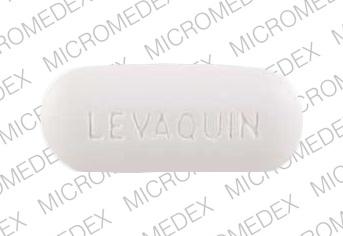Levaquin Dosage
Generic name: levofloxacin 250mg
Dosage form: tablets, oral solution, injection
Drug class: Quinolones and fluoroquinolones
Medically reviewed by Drugs.com. Last updated on Dec 30, 2024.
Dosage of LEVAQUIN® Tablets in Adult Patients with Creatinine Clearance ≥ 50 mL/minute
The usual dose of LEVAQUIN® Tablets is 250 mg, 500 mg, or 750 mg administered orally every 24 hours, as indicated by infection and described in Table 1.
These recommendations apply to patients with creatinine clearance ≥ 50 mL/minute. For patients with creatinine clearance less than 50 mL/min, adjustments to the dosing regimen are required.
| Type of Infection* | Dosed Every 24 hours | Duration (days)† |
|---|---|---|
|
||
| Nosocomial Pneumonia | 750 mg | 7 to 14 |
| Community Acquired Pneumonia‡ | 500 mg‡ | 7 to 14‡ |
| Community Acquired Pneumonia§ | 750 mg§ | 5§ |
| Complicated Skin and Skin Structure Infections (SSSI) | 750 mg | 7 to 14 |
| Uncomplicated SSSI | 500 mg | 7 to 10 |
| Chronic Bacterial Prostatitis | 500 mg | 28 |
| Inhalational Anthrax (Post-Exposure), adult and pediatric patients weighing 50 kg ¶,# or greater | 500 mg | 60# |
| Pediatric patients weighing 30 kg to less than 50 kg¶,# | see Table 2 below (2.2) | 60# |
| Plague, adult and pediatric patients weighing 50 kg Þ or greater Pediatric patients weighing 30 kg to less than 50 kg |
500 mg | 10 to 14 |
| see Table 2 below (2.2) | 10 to 14 | |
| Complicated Urinary Tract Infection (cUTI) or Acute Pyelonephritis (AP)ß | 750 mg | 5 |
| Complicated Urinary Tract Infection (cUTI) or Acute Pyelonephritis (AP)à | 250 mgà | 10à |
| Uncomplicated Urinary Tract Infection | 250 mg | 3 |
| Acute Bacterial Exacerbation of Chronic Bronchitis (ABECB) | 500 mg | 7 |
| Acute Bacterial Sinusitis (ABS) | 750 mg | 5 |
| 500 mg | 10 to 14 | |
Dosage of LEVAQUIN® Tablets in Pediatric Patients with Inhalational Anthrax or Plague
The dosage of LEVAQUIN® Tablets for inhalational anthrax (post-exposure) and plague in pediatric patients who weigh 30 kg or greater is described below in Table 2. LEVAQUIN® Tablets cannot be administered to patients who weigh less than 30 kg because of the limitations of the available strength. Alternative formulations of levofloxacin may be considered for pediatric patients who weigh less than 30 kg.
| Type of Infection* | Dose | Frequency | Duration† |
|---|---|---|---|
|
|||
| Inhalational Anthrax (post-exposure)‡,§ | |||
| Pediatric patients weighing 50 kg or greater | 500 mg | every 24 hours | 60 days§ |
| Pediatric patients weighing 30 kg to less than 50 kg | 250 mg | every 12 hours | 60 days§ |
| Plague¶ | |||
| Pediatric patients weighing 50 kg or greater | 500 mg | every 24 hours | 10 to 14 days |
| Pediatric patients weighing 30 kg to less than 50 kg | 250 mg | every 12 hours | 10 to 14 days |
Dosage Adjustment in Adults with Renal Impairment
Administer LEVAQUIN® with caution in patients with renal impairment. Careful clinical observation and appropriate laboratory studies should be performed prior to and during therapy since elimination of levofloxacin may be reduced in these patients.
In patients with renal impairment (creatinine clearance less than 50 mL/min), adjustment of the dosage regimen is necessary to avoid the accumulation of levofloxacin due to decreased clearance. No adjustment is necessary for patients with a creatinine clearance greater than or equal to 50 mL/minute.
Table 3 shows how to adjust dose based on creatinine clearance.
| Creatinine Clearance greater than or equal to 50 mL/minute | Creatinine Clearance 20 to 49 mL/minute | Creatinine Clearance 10 to 19 mL/minute | Hemodialysis or Chronic Ambulatory Peritoneal Dialysis (CAPD) |
|---|---|---|---|
| 750 mg every 24 hours | 750 mg every 48 hours | 750 mg initial dose, then 500 mg every 48 hours | 750 mg initial dose, then 500 mg every 48 hours |
| 500 mg every 24 hours | 500 mg initial dose, then 250 mg every 24 hours | 500 mg initial dose, then 250 mg every 48 hours | 500 mg initial dose, then 250 mg every 48 hours |
| 250 mg every 24 hours | No dosage adjustment required | 250 mg every 48 hours. If treating uncomplicated UTI, then no dosage adjustment is required |
No information on dosing adjustment is available |
Drug Interaction With Chelation Agents: Antacids, Sucralfate, Metal Cations, Multivitamins
LEVAQUIN® Tablets should be administered at least two hours before or two hours after antacids containing magnesium, aluminum, as well as sucralfate, metal cations such as iron, and multivitamin preparations with zinc or didanosine chewable/buffered tablets or the pediatric powder for oral solution.
Important Administration Instructions
LEVAQUIN® Tablets can be administered without regard to food.
If patients miss a dose, they should take it as soon as possible anytime up to 8 hours prior to their next scheduled dose. If less than 8 hours remain before the next dose, wait until their next scheduled dose.
Frequently asked questions
- What are the best antibiotics for pneumonia?
- Can you take Levaquin for an infected tooth?
- Can Levaquin cause tendonitis?
- What is the best antibiotic to treat a sinus infection?
- What antibiotics are used to treat UTI?
More about Levaquin (levofloxacin)
- Check interactions
- Compare alternatives
- Reviews (410)
- Drug images
- Side effects
- Patient tips
- During pregnancy
- Generic availability
- Support group
- Drug class: quinolones and fluoroquinolones
- Breastfeeding
Patient resources
Professional resources
Related treatment guides
See also:
Further information
Always consult your healthcare provider to ensure the information displayed on this page applies to your personal circumstances.


